Page 324 of 386
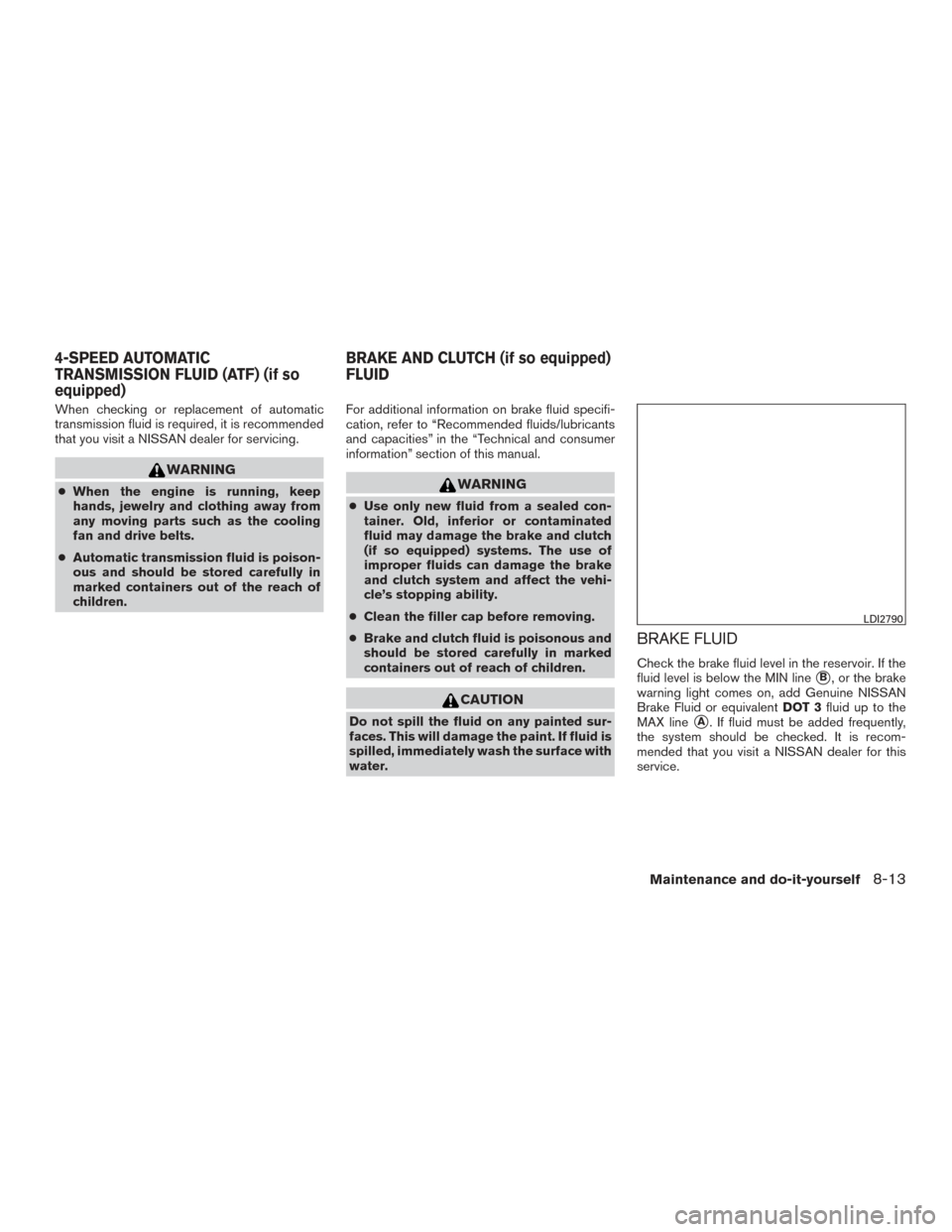
When checking or replacement of automatic
transmission fluid is required, it is recommended
that you visit a NISSAN dealer for servicing.
WARNING
●When the engine is running, keep
hands, jewelry and clothing away from
any moving parts such as the cooling
fan and drive belts.
● Automatic transmission fluid is poison-
ous and should be stored carefully in
marked containers out of the reach of
children. For additional information on brake fluid specifi-
cation, refer to “Recommended fluids/lubricants
and capacities” in the “Technical and consumer
information” section of this manual.WARNING
●
Use only new fluid from a sealed con-
tainer. Old, inferior or contaminated
fluid may damage the brake and clutch
(if so equipped) systems. The use of
improper fluids can damage the brake
and clutch system and affect the vehi-
cle’s stopping ability.
● Clean the filler cap before removing.
● Brake and clutch fluid is poisonous and
should be stored carefully in marked
containers out of reach of children.
CAUTION
Do not spill the fluid on any painted sur-
faces. This will damage the paint. If fluid is
spilled, immediately wash the surface with
water.
BRAKE FLUID
Check the brake fluid level in the reservoir. If the
fluid level is below the MIN line
�B, or the brake
warning light comes on, add Genuine NISSAN
Brake Fluid or equivalent DOT 3fluid up to the
MAX line
�A. If fluid must be added frequently,
the system should be checked. It is recom-
mended that you visit a NISSAN dealer for this
service.
LDI2790
4-SPEED AUTOMATIC
TRANSMISSION FLUID (ATF) (if so
equipped) BRAKE AND CLUTCH (if so equipped)
FLUID
Maintenance and do-it-yourself8-13
Page 325 of 386
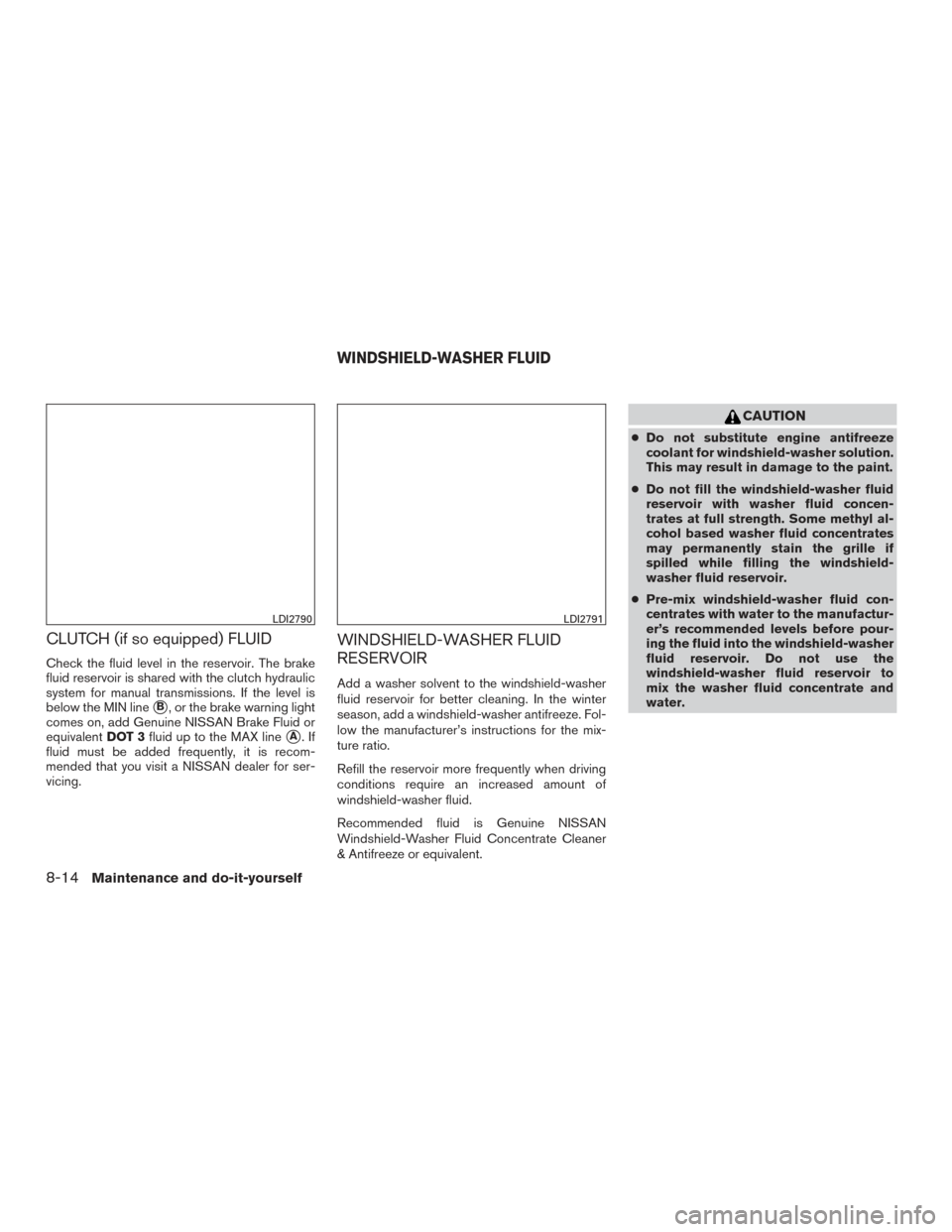
CLUTCH (if so equipped) FLUID
Check the fluid level in the reservoir. The brake
fluid reservoir is shared with the clutch hydraulic
system for manual transmissions. If the level is
below the MIN line
�B, or the brake warning light
comes on, add Genuine NISSAN Brake Fluid or
equivalent DOT 3fluid up to the MAX line
�A.If
fluid must be added frequently, it is recom-
mended that you visit a NISSAN dealer for ser-
vicing.
WINDSHIELD-WASHER FLUID
RESERVOIR
Add a washer solvent to the windshield-washer
fluid reservoir for better cleaning. In the winter
season, add a windshield-washer antifreeze. Fol-
low the manufacturer’s instructions for the mix-
ture ratio.
Refill the reservoir more frequently when driving
conditions require an increased amount of
windshield-washer fluid.
Recommended fluid is Genuine NISSAN
Windshield-Washer Fluid Concentrate Cleaner
& Antifreeze or equivalent.
CAUTION
● Do not substitute engine antifreeze
coolant for windshield-washer solution.
This may result in damage to the paint.
● Do not fill the windshield-washer fluid
reservoir with washer fluid concen-
trates at full strength. Some methyl al-
cohol based washer fluid concentrates
may permanently stain the grille if
spilled while filling the windshield-
washer fluid reservoir.
● Pre-mix windshield-washer fluid con-
centrates with water to the manufactur-
er’s recommended levels before pour-
ing the fluid into the windshield-washer
fluid reservoir. Do not use the
windshield-washer fluid reservoir to
mix the washer fluid concentrate and
water.
LDI2790LDI2791
WINDSHIELD-WASHER FLUID
8-14Maintenance and do-it-yourself
Page 326 of 386
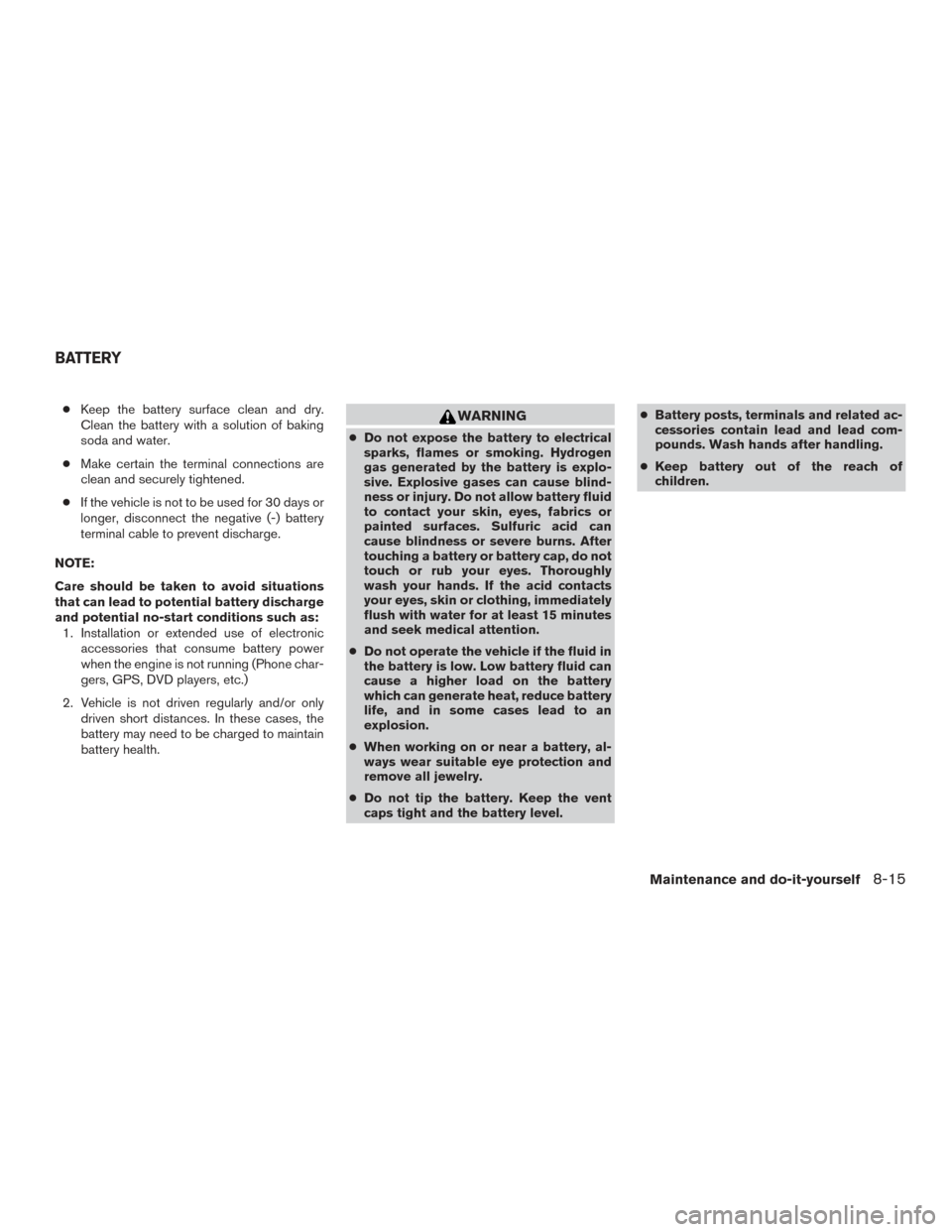
●Keep the battery surface clean and dry.
Clean the battery with a solution of baking
soda and water.
● Make certain the terminal connections are
clean and securely tightened.
● If the vehicle is not to be used for 30 days or
longer, disconnect the negative (-) battery
terminal cable to prevent discharge.
NOTE:
Care should be taken to avoid situations
that can lead to potential battery discharge
and potential no-start conditions such as: 1. Installation or extended use of electronic accessories that consume battery power
when the engine is not running (Phone char-
gers, GPS, DVD players, etc.)
2. Vehicle is not driven regularly and/or only driven short distances. In these cases, the
battery may need to be charged to maintain
battery health.WARNING
●Do not expose the battery to electrical
sparks, flames or smoking. Hydrogen
gas generated by the battery is explo-
sive. Explosive gases can cause blind-
ness or injury. Do not allow battery fluid
to contact your skin, eyes, fabrics or
painted surfaces. Sulfuric acid can
cause blindness or severe burns. After
touching a battery or battery cap, do not
touch or rub your eyes. Thoroughly
wash your hands. If the acid contacts
your eyes, skin or clothing, immediately
flush with water for at least 15 minutes
and seek medical attention.
● Do not operate the vehicle if the fluid in
the battery is low. Low battery fluid can
cause a higher load on the battery
which can generate heat, reduce battery
life, and in some cases lead to an
explosion.
● When working on or near a battery, al-
ways wear suitable eye protection and
remove all jewelry.
● Do not tip the battery. Keep the vent
caps tight and the battery level. ●
Battery posts, terminals and related ac-
cessories contain lead and lead com-
pounds. Wash hands after handling.
● Keep battery out of the reach of
children.
BATTERY
Maintenance and do-it-yourself8-15
Page 327 of 386
1. Remove the battery vent caps with a screw-driver as shown.
2. Check the fluid level in each cell. If it isnecessary to add fluid, add only distilled
water to bring the level up to the bottom of
the filler opening. Do not overfill.
3. Reinstall the battery vent caps. Vehicles operated in high temperatures or under
severe conditions require frequent checks of the
battery fluid level.
JUMP STARTING
If jump starting is necessary, refer to “Jump start-
ing” in the “In case of emergency” section of this
manual. If the engine does not start by jump
starting, the battery may have to be replaced. It is
recommended that you visit a NISSAN dealer for
this service.
WDI0701
WDI0529
8-16Maintenance and do-it-yourself
Page 328 of 386
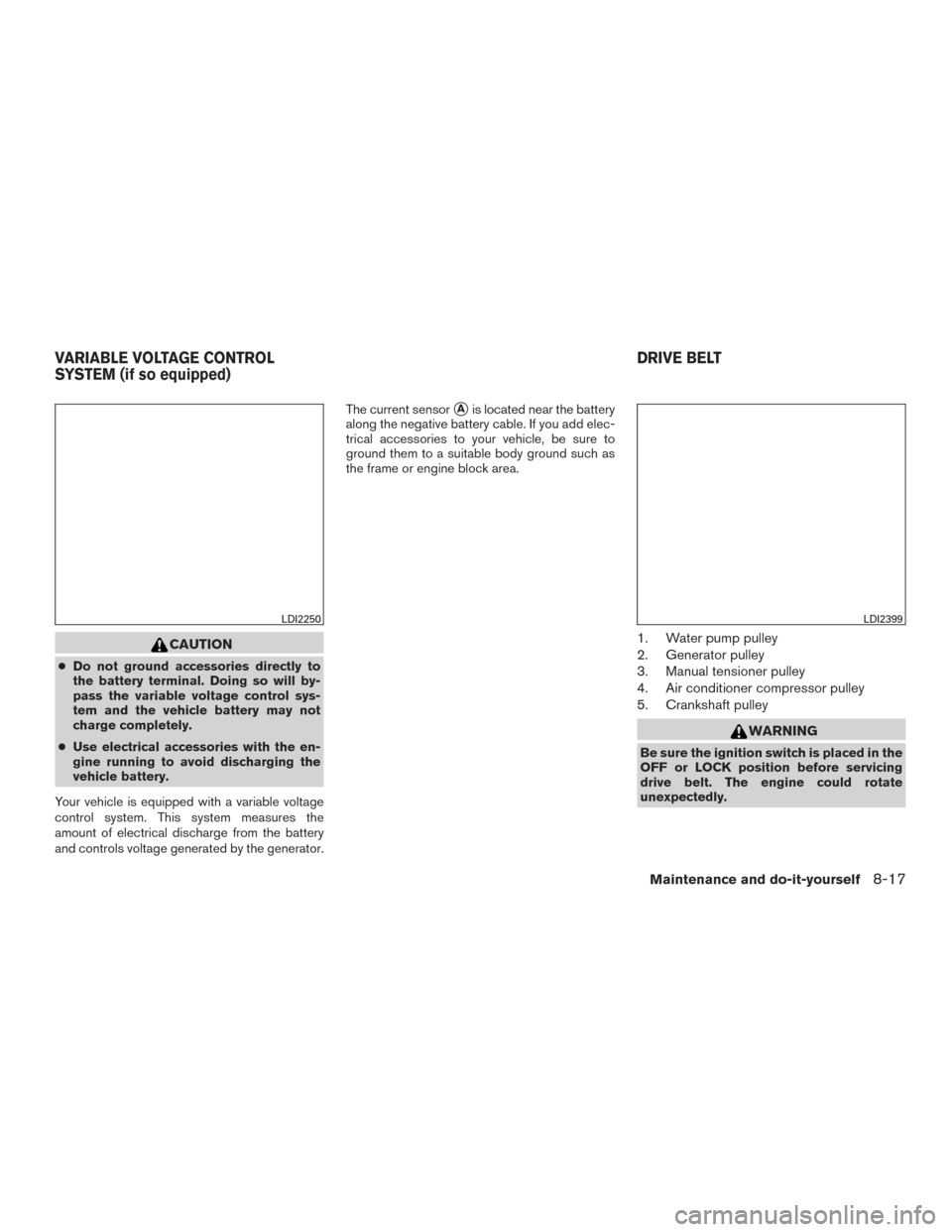
CAUTION
●Do not ground accessories directly to
the battery terminal. Doing so will by-
pass the variable voltage control sys-
tem and the vehicle battery may not
charge completely.
● Use electrical accessories with the en-
gine running to avoid discharging the
vehicle battery.
Your vehicle is equipped with a variable voltage
control system. This system measures the
amount of electrical discharge from the battery
and controls voltage generated by the generator. The current sensor
�Ais located near the battery
along the negative battery cable. If you add elec-
trical accessories to your vehicle, be sure to
ground them to a suitable body ground such as
the frame or engine block area.
1. Water pump pulley
2. Generator pulley
3. Manual tensioner pulley
4. Air conditioner compressor pulley
5. Crankshaft pulley
WARNING
Be sure the ignition switch is placed in the
OFF or LOCK position before servicing
drive belt. The engine could rotate
unexpectedly.
LDI2250LDI2399
VARIABLE VOLTAGE CONTROL
SYSTEM (if so equipped) DRIVE BELT
Maintenance and do-it-yourself8-17
Page 329 of 386
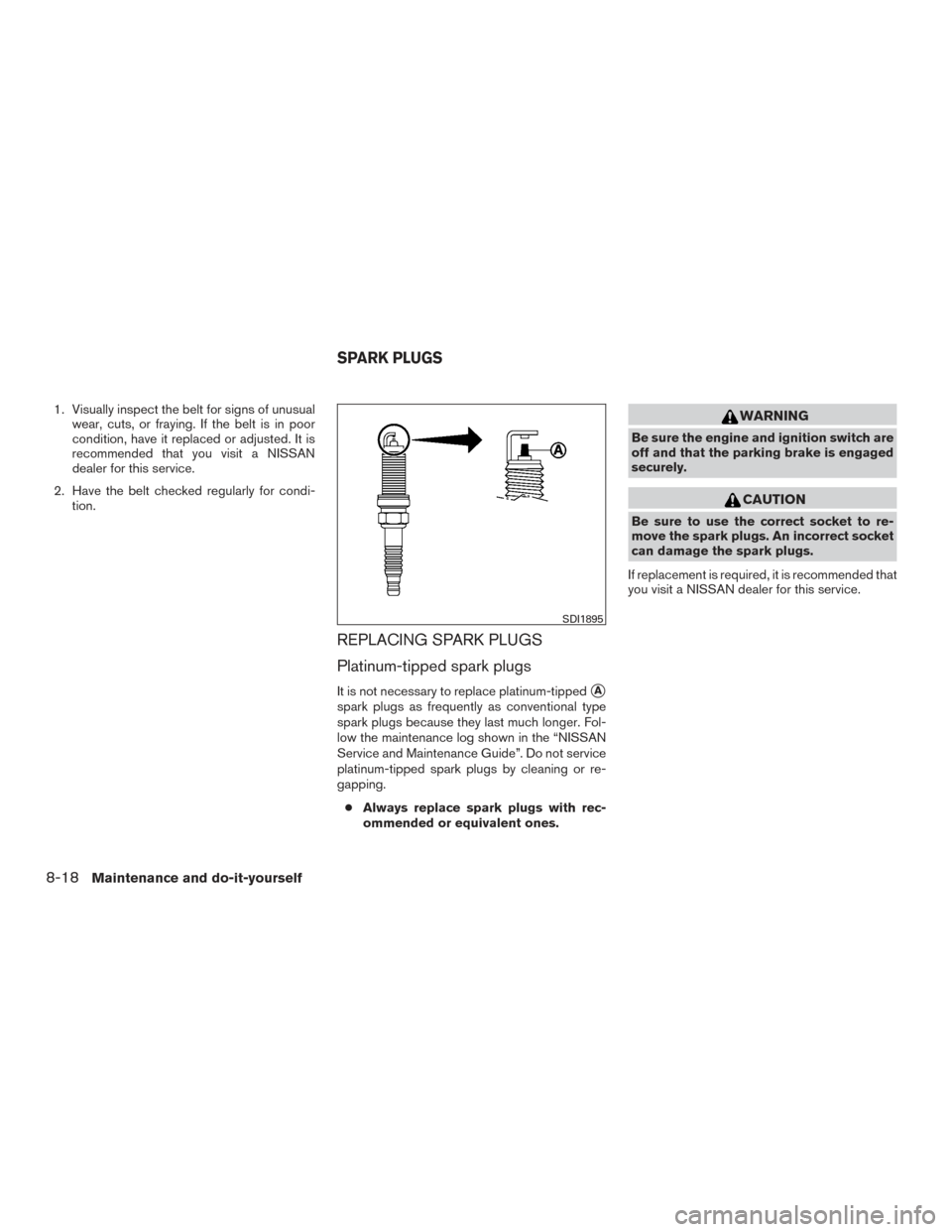
1. Visually inspect the belt for signs of unusualwear, cuts, or fraying. If the belt is in poor
condition, have it replaced or adjusted. It is
recommended that you visit a NISSAN
dealer for this service.
2. Have the belt checked regularly for condi- tion.
REPLACING SPARK PLUGS
Platinum-tipped spark plugs
It is not necessary to replace platinum-tipped�A
spark plugs as frequently as conventional type
spark plugs because they last much longer. Fol-
low the maintenance log shown in the “NISSAN
Service and Maintenance Guide”. Do not service
platinum-tipped spark plugs by cleaning or re-
gapping.
● Always replace spark plugs with rec-
ommended or equivalent ones.
WARNING
Be sure the engine and ignition switch are
off and that the parking brake is engaged
securely.
CAUTION
Be sure to use the correct socket to re-
move the spark plugs. An incorrect socket
can damage the spark plugs.
If replacement is required, it is recommended that
you visit a NISSAN dealer for this service.
SDI1895
SPARK PLUGS
8-18Maintenance and do-it-yourself
Page 330 of 386
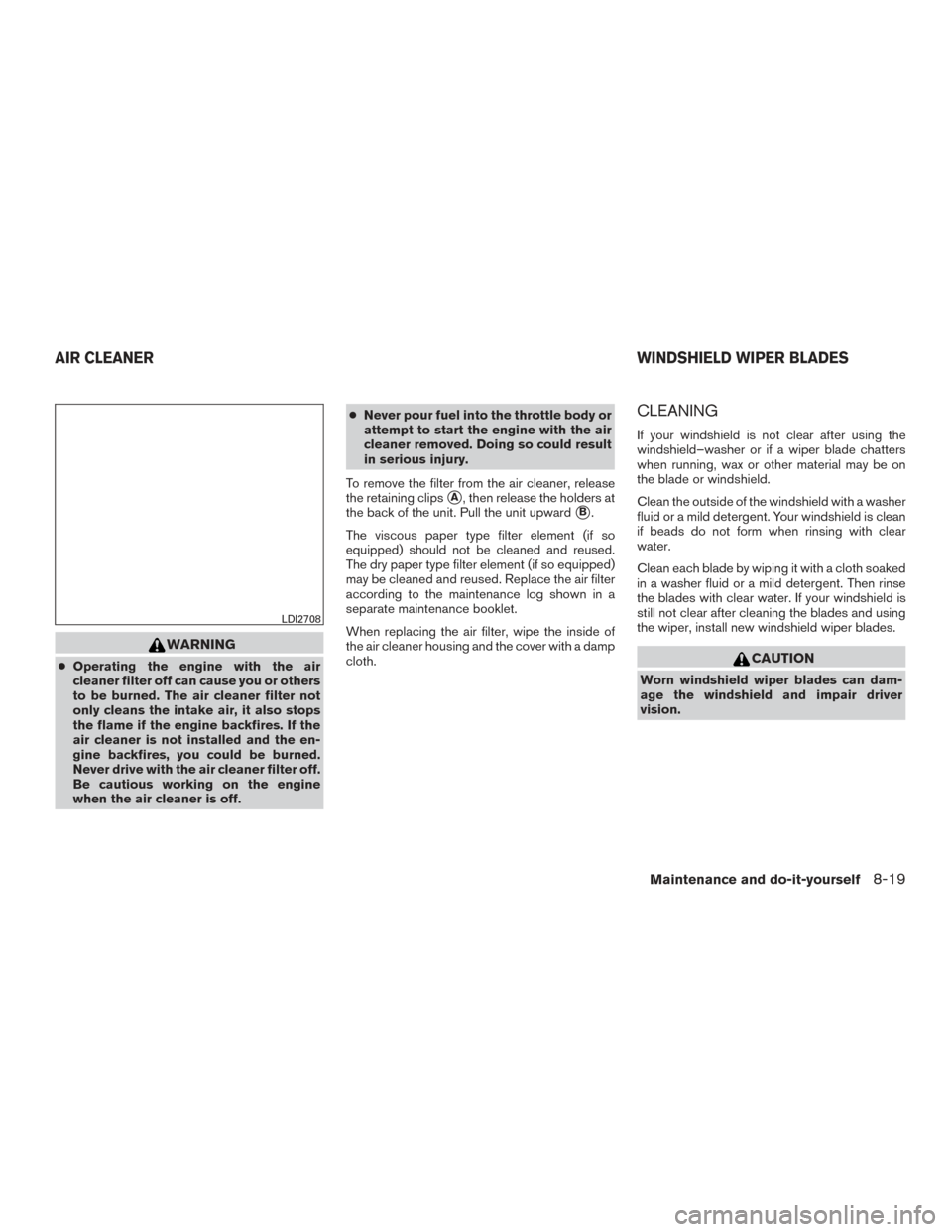
WARNING
●Operating the engine with the air
cleaner filter off can cause you or others
to be burned. The air cleaner filter not
only cleans the intake air, it also stops
the flame if the engine backfires. If the
air cleaner is not installed and the en-
gine backfires, you could be burned.
Never drive with the air cleaner filter off.
Be cautious working on the engine
when the air cleaner is off. ●
Never pour fuel into the throttle body or
attempt to start the engine with the air
cleaner removed. Doing so could result
in serious injury.
To remove the filter from the air cleaner, release
the retaining clips
�A, then release the holders at
the back of the unit. Pull the unit upward
�B.
The viscous paper type filter element (if so
equipped) should not be cleaned and reused.
The dry paper type filter element (if so equipped)
may be cleaned and reused. Replace the air filter
according to the maintenance log shown in a
separate maintenance booklet.
When replacing the air filter, wipe the inside of
the air cleaner housing and the cover with a damp
cloth.
CLEANING
If your windshield is not clear after using the
windshield–washer or if a wiper blade chatters
when running, wax or other material may be on
the blade or windshield.
Clean the outside of the windshield with a washer
fluid or a mild detergent. Your windshield is clean
if beads do not form when rinsing with clear
water.
Clean each blade by wiping it with a cloth soaked
in a washer fluid or a mild detergent. Then rinse
the blades with clear water. If your windshield is
still not clear after cleaning the blades and using
the wiper, install new windshield wiper blades.
CAUTION
Worn windshield wiper blades can dam-
age the windshield and impair driver
vision.
LDI2708
AIR CLEANER WINDSHIELD WIPER BLADES
Maintenance and do-it-yourself8-19
Page 333 of 386
ENGINE COMPARTMENT
Fusible links
If any electrical equipment does not operate and
the fuses are in good condition, check the fusible
links
�Ain the holder. If any of the fusible links are
melted, replace only with Genuine NISSAN
parts.
For checking and replacing the fusible links, it is
recommended that you visit a NISSAN dealer.
PASSENGER COMPARTMENT
WARNING
Never use a fuse of a higher or lower
amperage rating than specified on the
fuse box cover. This could damage the
electrical system or cause a fire.
If any electrical equipment does not operate,
check for an open fuse. NOTE:
The fuse box is located on the driver’s side
of the instrument panel.
1. Be sure the ignition switch and the headlight switch are OFF.
2. Remove the fuse box cover
�Awith a suit-
able tool. Use a cloth to avoid damaging the
trim.
3. Locate the fuse that needs to be replaced.
4. Remove the fuse with the fuse puller
�B.
LDI2792LDI2712
8-22Maintenance and do-it-yourself